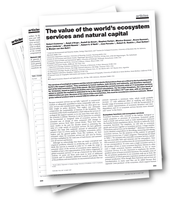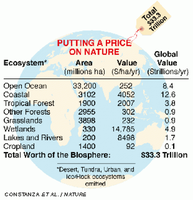1.3.1 Academic milestones of the Ecosystem Services Approach

 The ecosystem services approach was first developed by ecologists who were concerned about critical environmental problems, and was formalised in the 1970's for the purpose of providing political advice.
The ecosystem services approach was first developed by ecologists who were concerned about critical environmental problems, and was formalised in the 1970's for the purpose of providing political advice.
The origin of the concept can be traced back to the ‘Study of Critical Environmental Problem’ (SCEP), a report prepared in the Summer of 1970 by about 40 scientists and professionals from various disciplines under the supervision of Carroll L. Wilson, MIT Professor of Management, and William H. Matthews from the MIT Political Science Department [Mooney and Ehrlich, 1997 ]. The SCEP report contains a first typology of ‘environmental services’: “pest control, insect pollination, fisheries, climate regulation, soil retention, flood control, soil formation, cycling of matter, composition of the atmosphere” [SCEP, 1970
]. The SCEP report contains a first typology of ‘environmental services’: “pest control, insect pollination, fisheries, climate regulation, soil retention, flood control, soil formation, cycling of matter, composition of the atmosphere” [SCEP, 1970 ].
].
Ecosystem services have fed a lot of scientific debates and projects, which strengthened the interdisciplinary collaborations between natural scientists - mostly ecologists, and social scientists - mostly economists.
Since the 1990s, as they became convinced of the persuasive power of monetisation of Nature for conservation purposes, natural scientists and economists joined their efforts in order to estimate the “value” of ecosystem services or their contribution to human well-being [Gómez-Baggethun et al., 2010 ].
].
 A remarkable milestone in this process appeared to be the 1997 paper on “The value of the world’s ecosystem services and natural capital” published in the journal Nature by R. Costanza et al. [1997
A remarkable milestone in this process appeared to be the 1997 paper on “The value of the world’s ecosystem services and natural capital” published in the journal Nature by R. Costanza et al. [1997 ].
].
Within the decision-making sphere, the ecosystem services approach has been popularised by the publication in 2005 of the results of the Millennium Ecosystem Assessment [MEA, 2005 ], a study carried out by 1300 scientists from around the world under the umbrella of the United Nations Environment Program.
], a study carried out by 1300 scientists from around the world under the umbrella of the United Nations Environment Program.
This work stimulated the interest of high-level politicians toward in particular the economic significance of the global loss of biological diversity. This interest was formulated in the decisions of the "Potsdam Initiative-Biological Diversity 2010", which arose from a meeting between the Environment Ministers of the G8 countries and of Brazil, China, India, Mexico and South Africa, the European Commissioner responsible for the Environment and senior officials from the United Nations and the IUCN (The World Conservation Union) [Braat, 2012 ].
].
It opened the way for initiatives such as TEEB (The Economics of Ecosystems and Biodiversity), again under the umbrella of the UNEP [TEEB, 2010 ], and COPI (Costs of Policy Inaction), a study for the European Commission [Braat and ten Brik, 2010
], and COPI (Costs of Policy Inaction), a study for the European Commission [Braat and ten Brik, 2010 ].
].

